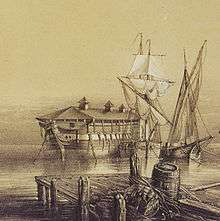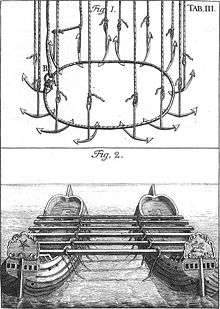Hulk (ship type)
A hulk is a ship that is afloat, but incapable of going to sea. Although sometimes used to describe a ship that has been launched but not completed, the term most often refers to an old ship that has had its rigging or internal equipment removed, retaining only its flotational qualities. The word "hulk" is also used as a verb: a ship is "hulked" to convert it to a hulk.
Although the term "hulk" can be used to refer to an abandoned wreck or shell, it is much more commonly applied to hulls that are still performing a useful function. In the days of sail, many hulls served longer as hulks than they did as functional ships. Wooden ships were often hulked when the hull structure became too old and weak to withstand the stresses of sailing.
More recently, ships have been hulked when they become obsolete or when they become uneconomical to operate.
Sheer hulk

A sheer hulk (or shear hulk) was used in shipbuilding and repair as a floating crane in the days of sailing ships, primarily to place the lower masts of a ship under construction or repair. Booms known as sheers were attached to the base of a hulk's lower masts or beam, supported from the top of those masts. Blocks & tackle were then used in such tasks as placing or removing the lower masts of vessel under construction or repair.
These lower masts were the largest and most massive single timbers aboard a ship, and erecting them without the assistance of either a sheer hulk or land-based masting sheer was extremely difficult.
Accommodation hulk

An accommodation hulk is a hulk used as housing, generally when there is a lack of quarters available ashore. An operational ship may be used for accommodation, but a hulk can accommodate more personnel than the same hull would accommodate as a functional ship. For this role, the hulk is often extensively modified to improve living conditions. Receiving hulks and prison hulks are specialized types of accommodation hulks. During World War II, purpose-built barracks ships were used in this role.
Receiving hulk

A receiving ship is a ship that is used in harbor to house newly recruited sailors before they are assigned to a ship's crew.[1]
In the Royal Navy, the use of impressment to collect sailors resulted in the problem of preventing escape of the unwilling "recruits." The receiving ship was part of the solution; it was difficult to get off the ship without being detected, and in any case most sailors before the mid-19th century did not know how to swim.
Receiving ships were typically older vessels that could still be kept afloat, but were obsolete or no longer seaworthy. The practice was especially common in the age of wooden ships, since the old hulls would remain afloat for many years in relatively still waters after they had become too weak to withstand the rigors of the open ocean.
Receiving ships often served as floating hospitals as many were assigned in locations without shore-based station hospitals. Often the afloat surgeon would take up station on the receiving ship.
Prison hulk
A prison hulk was a hulk used as a floating prison. They were used extensively in Great Britain, the Royal Navy producing a steady supply of ships too worn-out to use in combat, but still afloat. The harbour location of prison hulks was also convenient for the temporary holding of persons being transported to Australia and elsewhere overseas. These were decommissioned in the mid-19th century.
Powder hulk
A powder hulk was a hulk used to store gunpowder. The hulk was a floating warehouse which could be moved as needed to simplify the transfer of gunpowder to warships. Its location, away from land, also reduced the possible damage from an explosion.
Salvage pontoon
Hulks were used in pairs during salvage operations. By passing heavy cables under a wreck and connecting them to two hulks, a wreck could be raised using the lifting force of the tide or by changing the buoyancy of the hulks.
Floating storage and offloading units
Several of the largest former oil tankers were converted to floating production storage and offloading (FPSO) units, effectively very large floating oil storage tanks. The Knock Nevis, by some measures the largest ship ever built, served in this capacity from 2004 until 2010. In 2009 and 2010 two of the four TI-class supertankers, then the largest ships afloat, TI Asia and TI Africa, were converted to FPSOs.
Coal hulks
Service as a coal hulk was usually, but not always, a ship's last.
Of the fate of the fast and elegant clipper ships, William L. Carothers wrote, "Clippers functioned well as barges; their fine ends made for little resistance when under tow ... The ultimate degradation awaited a barge. There was no way up, only down-- down to the category of coal hulks ... Having strong solid bottoms ... they could handle the great weight of bulk coal which filled their holds. It was a grimy, untidy, unglamorous end for any vessel which had seen the glory days."[2]
The famed clipper Red Jacket ended her days as a coaling hulk in the Cape Verde Islands.
One by one these old Champions of the Seas disappeared. The Young America was last seen lying off Gibraltar as a coal hulk; and that superb old greyhound of the ocean, the Flying Cloud suffered a similar ignominious ending. She was not even spared the humiliation of concealing her tragic end from the eyes of her former envious rivals, but was condemned to end her days as a New Haven scow towed up the Sound with a load of brick and concrete behind a stuck up parvenu tug. Ever and anon as if to emphasize her newly acquired importance, the tug would bury the old-time square-rigged beauty in a cloud of filthy smoke. Imagine the feelings of an ex-Cape Horner under such conditions! There should have been a Society for the Prevention of Cruelty to Old Clippers. Everybody who knows anything about ships, knows that they have feelings just the same as anybody else.[3]— Henry Collins Brown, (1919), The Clipper Ships of Old New York, Valentine's Manual of Old New York, Issue 3, p. 94-95
Other services

A vessel's hulking may not be its final use. Scuttling as a blockship, breakwater, artificial reef, or recreational dive site may await. Some are repurposed, for example as a gambling ship; others are restored and put to new uses, such as a museum ship. Some even return revitalized to sea.
When lumber schooner Johanna Smith, "one of only two Pacific Coast steam schooners to be powered by steam turbines,"[4] was hulked in 1928, she was moored off Long Beach, California and used as a gambling ship, until a fire of unknown cause finished her off.
One vessel rescued from this ignominious end was the barque Polly Woodside, now a museum ship in Melbourne, Australia. Another is the James Craig, rescued from Recherche Bay in Tasmania, now restored and regularly sailing from Sydney, Australia.
See also
- British prison hulk
- Hospital ship
- Barracks ship
- Britannia Royal Naval College
- HMS Donegal (1858)
- Blockship
References
- ↑ "Receiving Ship". www.websters-online-dictionary.org. Retrieved 2009-10-30.
- ↑ Crothers, William L (1997). The American-built clipper ship, 1850-1856 : characteristics, construction, and details. Camden, ME: International Marine. ISBN 0-07-014501-6.
- ↑ Brown, Henry Collins (1919). "The Clipper Ships of Old New York". Valentine's Manual of Old New York (New York: Valentine's Manual) 3: 94–95. Retrieved May 2, 2010.
- ↑ Information on the wreck "Johanna Smith" Check
|url=
| Look up hulk in Wiktionary, the free dictionary. |
| Wikimedia Commons has media related to Hulks. |
| ||||||||||

